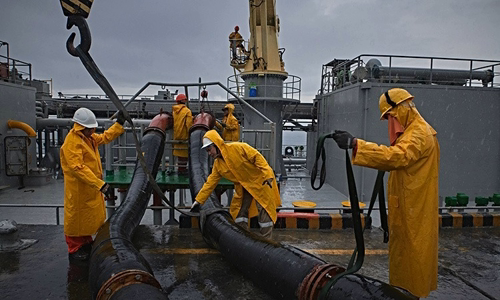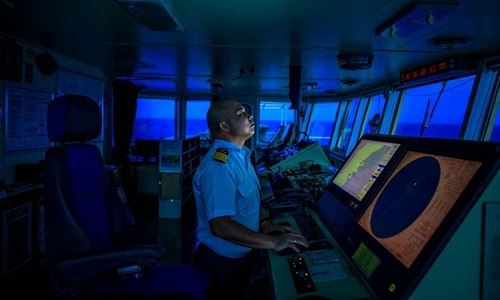7 years ago, during the first sea trip, Jun Russel Reunir had to scrape iron ore for more than 12 hours continuously, until the muscles ached and broke.
"That month, I cried three times in my cabin," recalls Reunir, 27, who now works on the UBC Cyprus ship in the North Pacific.

The crew of the UBC Cyprus ship in the port of Calaca, Philippines Photo: NY Times
For decades, Filipino ocean sailors such as Reunir have become a major force in the international shipping industry, responsible for transporting nearly 90% of global trade.
A few months ago, Reunir and 18 Filipino sailors drove a cement tanker from Japan to the Philippines. For hitchhikers on the train, that trip brings new sensations. The sound of the ocean waves was overwhelmed by the roar of the engine, flying fish scattered across the deck after a storm, or the smell of cheap oil filled the wind.
But for sailors, the day-to-day hard work of a ship is not as bad as the boredom when they relax. Romantic feelings for the sea seem to have died long ago.
Jayson Guanio, 29, the ship's cook, recounted that during a two-month ore trip from Montenegro to China, he once had to run up to the cockpit to look at a remote island hoping to see it. Something different from the sea.
But 51-year-old machine room sailor Arnulfo Abad, 51, who has been at sea for three decades, said he was satisfied with the job. "The sea has given me life," Abad said.
Most of the sailors on board come from the family of fishermen, carpenters or farmers. Becoming an officer, which all sailors desire, requires a university degree. Some people had to rely on the income of raising pigs or selling ice cream on the street to get that degree. They leave the poor rural areas with an income of about 100 USD per month to wander at sea with the money earned 10 times.
After the sea trips, they returned home with gold chains on their necks, built high and wide houses for their parents and helped their brothers and sisters or their grandchildren go to college. Then the marriage proposals came rushing.
Marine crews, a hard-working but well-paid job, became a "hot" job in the Philippines in the 1980s, when a career training campaign was organized. Many HR companies promote Filipino sailors to international shipping lines. Meanwhile, maritime training schools are mushrooming to meet the needs of those who want to follow this job.

UBC Cyprus captain, Rodrigo Soyoso, stands in the cockpit Photo: NY Times
In the past few years, the number of Vietnamese, Myanmar and Chinese sailors working on ships has increased. But of the 1.6 million sailors in the world, there are 400,000 Filipinos. In 2018, remittances sent by Filipino sailors reached US $ 6 billion. On the UBC Cyprus ship or many other ships, Philippine culture has always dominated.
Rodrigo Soyoso, Philippine captain, was originally an apprentice on a fishing boat of 30 crew members. Like everyone here, he only gets to shower once a week and has to tie his feet into a vent while sleeping on the deck to avoid falling into the sea.
Soyoso had towed tugs, pet carriers and cruise ships before advancing as an officer. As captain, Soyoso must ensure compliance with international maritime regulations, avoid collisions with other ships, monitor weather conditions at sea. The captain also had to deal with corrupt customs officials and stockpiled several cigarettes to make "a gift through the door" when needed.
They always keep the culture of the homeland even when eating, drinking or playing. They make whole roast pork, a popular dish in the Philippines. In the back deck of the ship, they also designed a basketball court, a very popular sport in their homeland.
On the UBC Cyprus ship, the crew were all men. Only 1% of the sailors on the ships are women.
In the karaoke on Saturday night, these men often sing songs that express the longing in their hearts. "How long will my longing heart wait for you?"
The internet has made the sailors' lives less lonely, but they only have 50 MB of free space to use. "Just go to Facebook and that's it," Captain Soyoso said.
Without the Internet, they just waited until the train passed an island to receive a phone signal. They huddled together in an area where mooring ropes and lifeboats try to collect enough signals to receive a message. Before the Internet, they often had to pull each other to the phone booth whenever the train docked to call relatives, or say love words like "I love you" to your wife or lover over the radio.

Jun Russel Reunir (left) looks at a girl's photo on her phone Photo: NY Times
The ocean is a very dangerous workplace. In the past 10 years, there have been 1,036 cases of missing ships at sea, including the flip of a cement tanker near Scotland, which killed all crew members.
The recoil of an anchor can tear a sailor's head off, a wire mesh can cut off his fingers, or a strong ocean wave hitting a ship's hull can cause them to fall over or fall into the sea. In addition, there are many other dangers such as electric shock, burns or appendicitis always lurking them. Meanwhile, the nearest hospital is a few hours to a few days flight by rescue helicopter.
However, according to Captain Soyoso, the biggest challenge for sailors is the feeling of isolation. While on the train, they are easily depressed, hopeless when there is no way to solve personal and family problems. Many people are no longer earnestly working and even desperate to the point of death.
Being away from home for many months is also very difficult. In April, Reunir was at the port when his wife called to give birth to a daughter. "Her first birthday might not have been possible for me," Reunir said.
Reunir said he wanted to be a sailor since childhood. After achieving this dream, he enjoyed sea adventures, traversed pirate-prone areas such as the Gulf of Aden, or coped with storms in the North Sea, accepting to live far away from him. love for 10 months.
After he went to the beach, the Philippine economy also prospered and had more job opportunities on the mainland. After seven years of sailing on freighter ships, now Reunir only dreams of returning to the small town where he grew up, cultivating and raising animals.
But until now, he still needs his wife to show his photos to her, so that when she sees each other again, she can recognize her father.



 AppleGabrielCabading
AppleGabrielCabading







